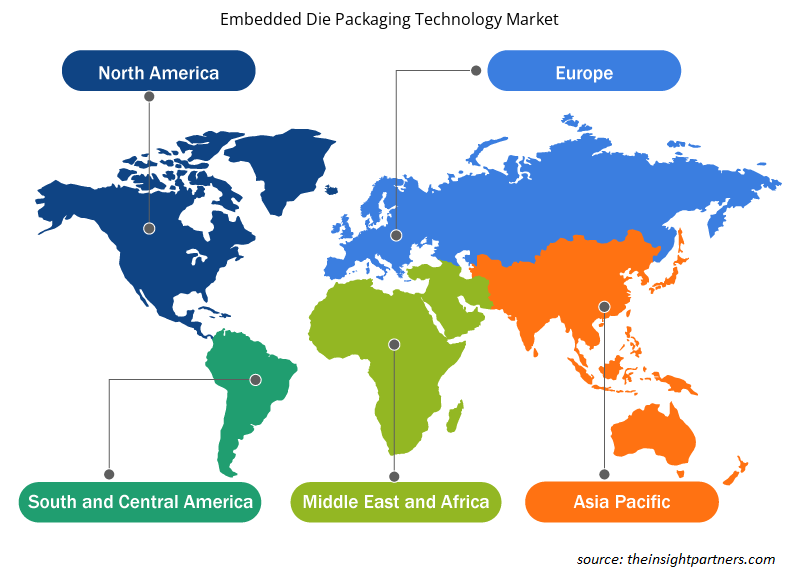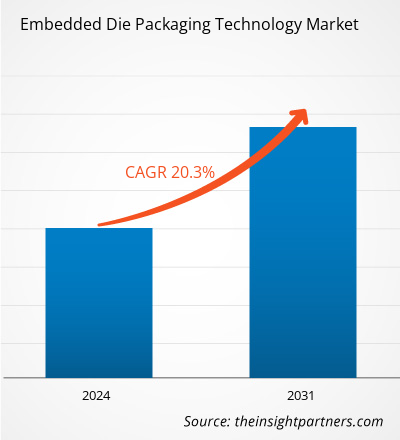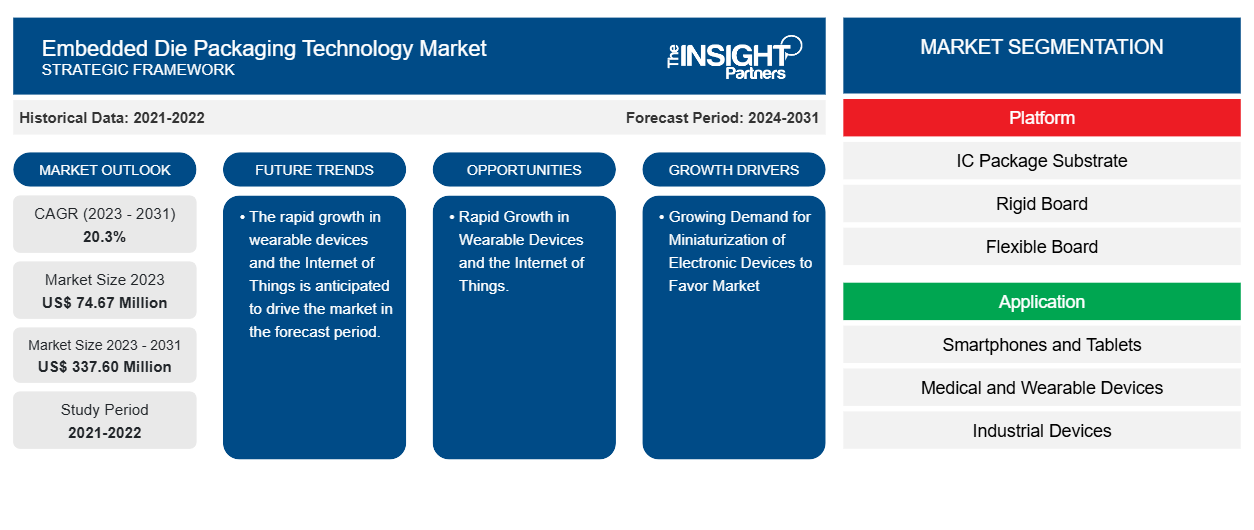Der Markt für Embedded-Die-Packaging-Technologie soll von 74,67 Millionen US-Dollar im Jahr 2023 auf 337,60 Millionen US-Dollar im Jahr 2031 anwachsen. Der Markt soll zwischen 2023 und 2031 eine durchschnittliche jährliche Wachstumsrate von 20,3 % verzeichnen. Die wachsende Nachfrage nach Miniaturisierung elektronischer Geräte und die zunehmende Entwicklung der Embedded-Die-Packaging-Technologie dürften die wichtigsten Treiber und Trends des Marktes sein.
Marktanalyse für Embedded Die Packaging-Technologie
Der Markt für Embedded-Die-Packaging-Technologie verzeichnet weltweit ein erhebliches Wachstum. Diese wachsende Nachfrage nach Miniaturisierung elektronischer Geräte und die zunehmende Entwicklung der Embedded-Die-Packaging-Technologie. Darüber hinaus sind die steigende Nachfrage nach Leistungssteigerungen bei Smartphones und Automobilgeräten sowie das schnelle Wachstum bei tragbaren Geräten und dem Internet der Dinge weitere Faktoren, die das Wachstum des Marktes für Handelsförderungsmanagement-Software fördern.
Marktübersicht für Embedded Die Packaging-Technologie
Das Embedded-Die-Packaging unterscheidet sich von den meisten anderen Package-Typen. In vielen IC-Packaging-Modellen befinden sich die Geräte im Allgemeinen auf einem Substrat. Das Substrat dient als Brücke zwischen den Geräten und einer Platine in einem System.
Passen Sie diesen Bericht Ihren Anforderungen an
Sie erhalten kostenlose Anpassungen an jedem Bericht, einschließlich Teilen dieses Berichts oder einer Analyse auf Länderebene, eines Excel-Datenpakets sowie tolle Angebote und Rabatte für Start-ups und Universitäten.
- Holen Sie sich die wichtigsten Markttrends aus diesem Bericht.Dieses KOSTENLOSE Beispiel umfasst eine Datenanalyse von Markttrends bis hin zu Schätzungen und Prognosen.
Markttreiber und Chancen für Embedded Die Packaging-Technologie
Wachsende Nachfrage nach Miniaturisierung elektronischer Geräte begünstigt den Markt
Die wachsende Nachfrage nach Miniaturisierung elektronischer Geräte treibt den Markt tatsächlich an. Bei der Miniaturisierung elektronischer Geräte werden mehr Transistorknoten auf einem kleineren integrierten Schaltkreis (IC) untergebracht. Der IC wird dann in das vorgesehene System oder Gerät eingebunden, sodass das System nach der Montage die gewünschte Funktion ausführen kann. Die Technologie wird dadurch kleiner und dennoch leistungsfähiger. Darüber hinaus wird durch die Einbettung des Chips in das Substrat der Gesamtabdruck des elektronischen Pakets erheblich reduziert. Dies ist insbesondere für Anwendungen von Vorteil, bei denen Platz knapp ist, wie etwa bei Mobilgeräten, Wearables und medizinischen Implantaten.
Schnelles Wachstum bei tragbaren Geräten und dem Internet der Dinge.
Das rasante Wachstum bei tragbaren Geräten und dem Internet der Dinge wird dem Markt für Embedded-Die-Packaging-Technologie in den kommenden Jahren voraussichtlich zahlreiche Chancen eröffnen. Tragbare Geräte werden die Grenzen zwischen der physischen und der digitalen Welt verwischen. Augmented-Reality-Brillen werden Informationen über die Umgebung einer Person einblenden und Echtzeit-Navigation, Übersetzungshilfe und sogar personalisierte Stadtführungen ermöglichen. Embedded-Die-Packaging-Technologie unterstützt tragbare Geräte in vielen IC-Paketen. Die Geräte befinden sich auf einem Substrat.IC packages. The devices are situated on top of a substrate.
Segmentierungsanalyse des Marktberichts zur Embedded Die Packaging-Technologie
Wichtige Segmente, die zur Ableitung der Marktanalyse für Embedded-Die-Packaging-Technologie beigetragen haben, sind Plattform, Anwendung und Branche.
- Basierend auf der Plattform ist der Markt für eingebettete Chip-Verpackungstechnologie in IC-Gehäusesubstrate, starre Platinen und flexible Platinen unterteilt. Das Segment der IC-Gehäusesubstrate wird im Prognosezeitraum voraussichtlich einen erheblichen Marktanteil halten.IC package substrate, rigid board, and flexible board. The IC package substrate segment is anticipated to hold a significant market share in the forecast period.
- Basierend auf der Anwendung ist der Markt für Embedded-Die-Packaging-Technologie in Smartphones und Tablets, medizinische und tragbare Geräte, Industriegeräte, Sicherheitsgeräte und andere Anwendungen unterteilt. Das Segment Smartphones und Tablets wird im Prognosezeitraum voraussichtlich einen erheblichen Marktanteil halten.
- Nach Branchen ist der Markt in Unterhaltungselektronik, IT und Telekommunikation, Automobil , Gesundheitswesen und andere Branchen unterteilt. Die Luft- und Raumfahrt sowie die Verteidigung werden im Prognosezeitraum voraussichtlich einen erheblichen Marktanteil halten.
Embedded Die Packaging-Technologie Marktanteilsanalyse nach Geografie
Der geografische Umfang des Marktberichts zur Embedded-Die-Packaging-Technologie ist hauptsächlich in fünf Regionen unterteilt: Nordamerika, Asien-Pazifik, Europa, Naher Osten und Afrika sowie Süd- und Mittelamerika.
Nordamerika dominiert den Markt für Embedded-Die-Packaging-Technologie. Die hohen Technologie-Annahmetrends in verschiedenen Branchen in der nordamerikanischen Region haben das Wachstum des Marktes für Embedded-Die-Packaging-Technologie vorangetrieben. Faktoren wie die zunehmende Nutzung digitaler Tools, hohe Technologieausgaben von Regierungsbehörden, die wachsende Nachfrage nach Miniaturisierung elektronischer Geräte und steigende Entwicklungen in der Embedded-Die-Packaging-Technologie werden voraussichtlich das Wachstum des nordamerikanischen Marktes für Embedded-Die-Packaging-Technologie vorantreiben. Darüber hinaus zwingt eine starke Betonung von Forschung und Entwicklung in den entwickelten Volkswirtschaften der USA und Kanadas die nordamerikanischen Akteure dazu, technologisch fortschrittliche Lösungen auf den Markt zu bringen. Darüber hinaus gibt es in den USA eine große Anzahl von Akteuren auf dem Markt für Embedded-Die-Packaging-Technologie, die sich zunehmend auf die Entwicklung innovativer Lösungen konzentrieren. All diese Faktoren tragen zum Wachstum des Marktes für Embedded-Die-Packaging-Technologie in der Region bei.fuelled the growth of the embedded die packaging technology market. Factors such as increased adoption of digital tools, high technological spending by government agencies, the growing demand for the miniaturization of electronic devices, and rising developments in embedded die packaging technology are expected to drive the North American embedded die packaging technology market growth. Moreover, a strong emphasis on research and development in the developed economies of the US and Canada is forcing the North American players to bring technologically advanced solutions into the market. In addition, the US has a large number of embedded die packaging technology market players who have been increasingly focusing on developing innovative solutions. All these factors contribute to the region's growth of the embedded die packaging technology market.
Regionale Einblicke in den Markt für Embedded Die Packaging-Technologie
Die regionalen Trends und Faktoren, die den Markt für Embedded Die Packaging Technology im Prognosezeitraum beeinflussen, wurden von den Analysten von Insight Partners ausführlich erläutert. In diesem Abschnitt werden auch die Marktsegmente und die Geografie der Embedded Die Packaging Technology in Nordamerika, Europa, im asiatisch-pazifischen Raum, im Nahen Osten und Afrika sowie in Süd- und Mittelamerika erörtert.

- Erhalten Sie regionale Daten zum Markt für Embedded Die Packaging-Technologie
Umfang des Marktberichts zur Embedded Die Packaging-Technologie
| Berichtsattribut | Details |
|---|---|
| Marktgröße im Jahr 2023 | 74,67 Millionen US-Dollar |
| Marktgröße bis 2031 | 337,60 Millionen US-Dollar |
| Globale CAGR (2023 - 2031) | 20,3 % |
| Historische Daten | 2021-2022 |
| Prognosezeitraum | 2024–2031 |
| Abgedeckte Segmente | Nach Plattform
|
| Abgedeckte Regionen und Länder | Nordamerika
|
| Marktführer und wichtige Unternehmensprofile |
|
Dichte der Marktteilnehmer im Bereich Embedded Die Packaging-Technologie: Die Auswirkungen auf die Geschäftsdynamik verstehen
Der Markt für Embedded Die Packaging Technology wächst rasant, angetrieben durch die steigende Endverbrauchernachfrage aufgrund von Faktoren wie sich entwickelnden Verbraucherpräferenzen, technologischen Fortschritten und einem größeren Bewusstsein für die Vorteile des Produkts. Mit steigender Nachfrage erweitern Unternehmen ihr Angebot, entwickeln Innovationen, um die Bedürfnisse der Verbraucher zu erfüllen, und nutzen neue Trends, was das Marktwachstum weiter ankurbelt.
Die Marktteilnehmerdichte bezieht sich auf die Verteilung der Firmen oder Unternehmen, die in einem bestimmten Markt oder einer bestimmten Branche tätig sind. Sie gibt an, wie viele Wettbewerber (Marktteilnehmer) in einem bestimmten Marktraum im Verhältnis zu seiner Größe oder seinem gesamten Marktwert präsent sind.
Die wichtigsten auf dem Markt für Embedded Die Packaging-Technologie tätigen Unternehmen sind:
- Amkor Technology, Inc.
- ASE-Gruppe
- AT & S Austria Technologie & Systemtechnik Aktiengesellschaft
- Fujikura Ltd.
- Allgemeine Elektrizit?tsgesellschaft
- INANE-ON TECHNOLOGIES AG
Haftungsausschluss : Die oben aufgeführten Unternehmen sind nicht in einer bestimmten Reihenfolge aufgeführt.

- Überblick über die wichtigsten Akteure auf dem Markt für Embedded Die Packaging-Technologie
Neuigkeiten und aktuelle Entwicklungen zum Markt für Embedded Die Packaging-Technologie
Der Markt für Embedded-Die-Packaging-Technologie wird durch die Erfassung qualitativer und quantitativer Daten nach Primär- und Sekundärforschung bewertet, die wichtige Unternehmensveröffentlichungen, Verbandsdaten und Datenbanken umfasst. Nachfolgend sind einige der Entwicklungen auf dem Markt für Embedded-Die-Packaging-Technologie aufgeführt:
- ASE fördert Embedded-Die-Packaging für Automobilelektronik. Das Backend-Unternehmen ASE Technology wird seine selbst entwickelte Embedded-Die-Technologie, genannt „Advanced Embedded Active System Integration (ASI), hauptsächlich zur Verarbeitung von elektronischen Automobilmodulen einsetzen (Quelle: ASE-Unternehmenswebsite, Mai 2024).
Marktbericht zur Embedded Die Packaging-Technologie – Abdeckung und Ergebnisse
Der Bericht „Marktgröße und Prognose für Embedded Die Packaging-Technologie (2021–2031)“ bietet eine detaillierte Analyse des Marktes, die die folgenden Bereiche abdeckt:
- Marktgröße und Prognose für Embedded-Die-Packaging-Technologie auf globaler, regionaler und Länderebene für alle abgedeckten wichtigen Marktsegmente.
- Markttrends im Bereich Embedded Die Packaging-Technologie sowie Marktdynamik wie treibende Faktoren, Hemmnisse und wichtige Chancen.
- Detaillierte PEST/Porters Five Forces- und SWOT-Analyse.
- Marktanalyse für Embedded-Die-Packaging-Technologie, die wichtige Markttrends, globale und regionale Rahmenbedingungen, wichtige Akteure, Vorschriften und aktuelle Marktentwicklungen abdeckt.
- Branchenlandschaft und Wettbewerbsanalyse, einschließlich Marktkonzentration, Heatmap-Analyse, prominenten Akteuren und aktuellen Entwicklungen auf dem Markt für Embedded-Die-Packaging-Technologie.
- Detaillierte Firmenprofile.
- Historische Analyse (2 Jahre), Basisjahr, Prognose (7 Jahre) mit CAGR
- PEST- und SWOT-Analyse
- Marktgröße Wert/Volumen – Global, Regional, Land
- Branchen- und Wettbewerbslandschaft
- Excel-Datensatz
Aktuelle Berichte
Verwandte Berichte
Erfahrungsberichte
Grund zum Kauf
- Fundierte Entscheidungsfindung
- Marktdynamik verstehen
- Wettbewerbsanalyse
- Kundeneinblicke
- Marktprognosen
- Risikominimierung
- Strategische Planung
- Investitionsbegründung
- Identifizierung neuer Märkte
- Verbesserung von Marketingstrategien
- Steigerung der Betriebseffizienz
- Anpassung an regulatorische Trends





















 Kostenlose Probe anfordern für - Markt für Embedded-Die-Packaging-Technologie
Kostenlose Probe anfordern für - Markt für Embedded-Die-Packaging-Technologie